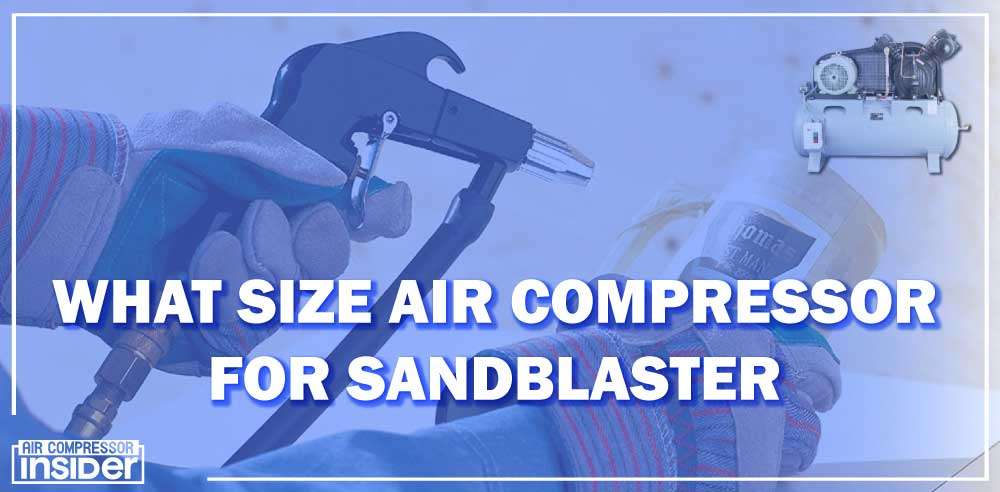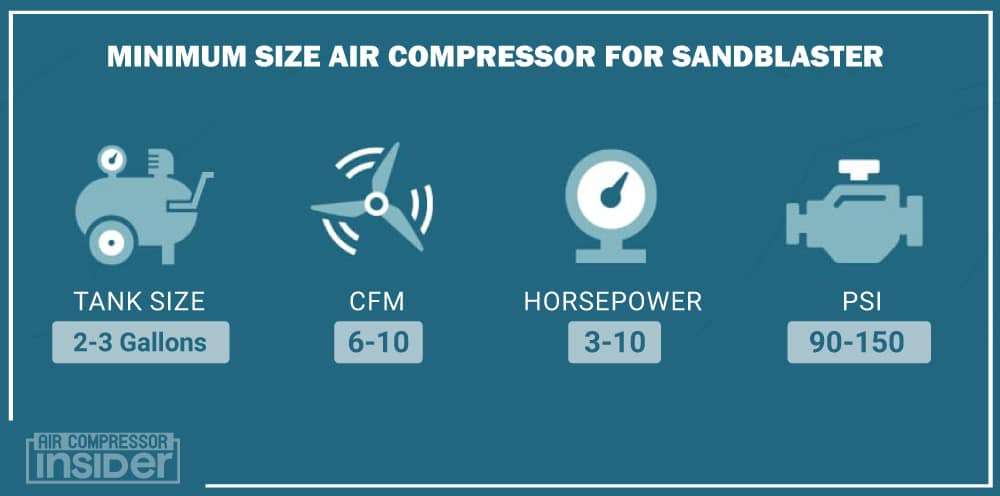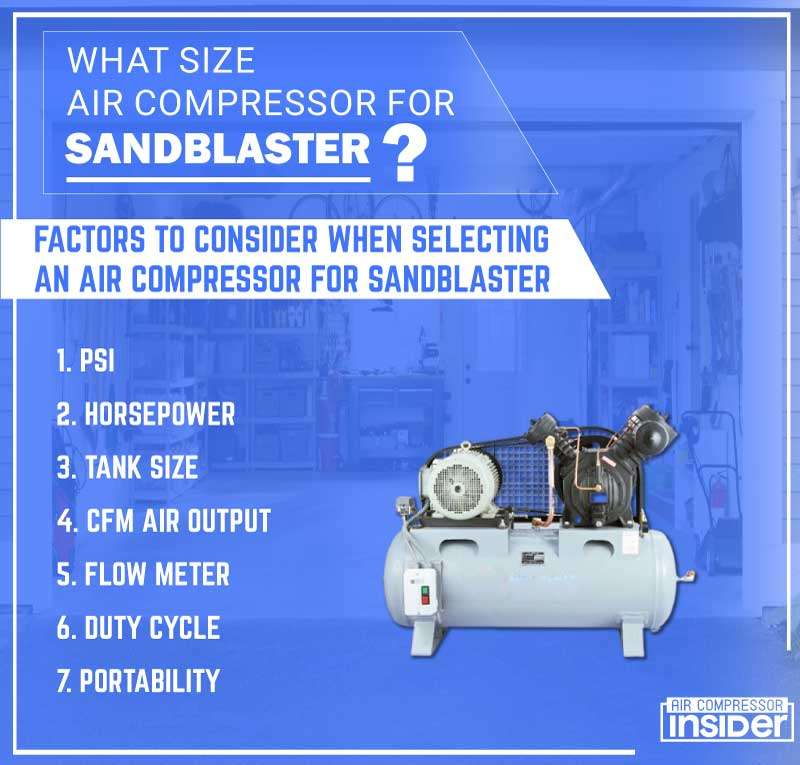When it comes to sandblasting, one of the most important pieces of equipment you need is an air compressor. But with so many different sizes and types of air compressors on the market, it can be tough to know what size air compressor for sandblaster is required for your task.
In this blog post, we’ll break down everything you need to know about choosing the best size air compressor for sandblasting, so you can get the job done right.
What Size Air Compressor For Sandblaster
When using an air compressor for sandblasting, it is important to know how much air volume the compressor can generate and at what pressure. Most sandblasting applications require a minimum of 90 PSI and at least 4-5 CFM (cubic feet per minute). If you’re using a smaller air compressor such as Makita AC310H, you’ll likely need to increase the tank size to get the desired results.

- What Size Air Compressor For Sandblaster
- What Is A Sandblaster?
- Types of Sandblaster:
- Important Factors to Consider When Selecting an Air Compressor for Sandblaster:
- Is Portable Air Compressor Required For Sandblaster?
- How To Use A Sandblaster With Air Compressor?
- What Are The Benefits Of Using A Sandblaster With Air Compressor?
- Safety Precautions to Follow When Using Sandblaster With Air Compressor:
- Conclusion:
For a sandblaster, you’ll need an air compressor with a CFM rating of at least 6-10 and a PSI rating around 90-150. HP should be in the 3-10 range, and the tank size should be around 2-3 gallons or higher.

What Is A Sandblaster?
A sandblaster is a machine that uses sand to clean or finish a workpiece. Sandblasting is a process of propelling sand at high velocity against a workpiece to clean it or add a textured finish. Sandblasting is often used to remove paint, rust, or other unwanted deposits from metal, glass, or stone surfaces.
Also Read: What Size Air Compressor For Walnut Blasting
Types of Sandblaster:
Different types of sandblasters are available in the market to suit different needs. These include:
1. Mini Sandblasters
2. Portable Sandblasters
3. Benchtop Sandblasters
4. Industrial Sandblasters
1. Mini Sandblasters:
Mini sandblasters are perfect for small jobs like removing rust from tools or cleaning jewelry. They are also great for hobbyists who need to blast small areas.
2. Portable Sandblasters:
Portable sandblasters are ideal for larger jobs like stripping paint from a car or removing rust from a piece of machinery. They are also great for larger projects like sandblasting a patio or driveway.
3. Benchtop Sandblasters:
Benchtop sandblasters are perfect for professional use. They are powerful enough to handle big jobs, but still small enough to be easily maneuverable.
4. Industrial Sandblasters:
Industrial sandblasters are the most powerful type of sandblaster. They are designed for heavy-duty use and can handle even the most stubborn materials.
Also Read: What Size Air Compressor For Media Blasting
Important Factors to Consider When Selecting an Air Compressor for Sandblaster:

How Much PSI Is Required For Sandblaster?
The amount of PSI you’ll need will depend on a few factors, including the type of air compressor you’re using and the size of the nozzle. Generally speaking, you’ll need an air compressor that can deliver at least 90 PSI of pressure. But if you’re using a smaller nozzle, you may need a high pressure air compressor that can deliver even more pressure – up to 150 PSI or more.
How Much CFM Is Required For Sandblaster?
The amount of CFM (cubic feet per minute) that is required depends on the size of the sandblaster, the type of media being used, and the desired outcome.
The first thing to consider is the size of the sandblaster. A larger sandblaster will require more CFM to operate effectively. The type of media being used will also affect the CFM requirement. If you are using a finer media, such as sand, you will need more CFM than if you are using a coarser media, such as gravel.
The desired outcome also plays a role in determining the CFM requirement. If you are looking for a smoother finish, you will need more CFM than if you are just looking to remove paint or rust. Generally speaking, you will need between 3 and 6 CFM to operate a sandblaster effectively. If you are using a larger sandblaster or a finer media, you may need up to 10 CFM. If you are unsure how much CFM your sandblaster requires, consult the manufacturer’s instructions.
How Much Horse Power Is Required For Sandblaster?
The amount of horse power (HP) required for your air compressor will depend on the size of your project and the type of air compressor you are using. For portable air compressors, the HP rating is typically between 3 and 10 HP. For stationary air compressors, the HP rating can be as high as 200 HP.
What Tank Size Is Required For Sandblaster?
To determine the size of tank you need, you first need to determine the CFM (cubic feet per minute) rating of your compressor. This is the amount of air the compressor can produce in a minute. Once you have this number, you can use the following formula to determine the size of tank you need:
Tank Size (in gallons) = CFM Rating of Compressor / 4
For example, if your compressor has a CFM rating of 10, you would need a 2.5 gallons air compressor.
Keep in mind that this is just a general guideline. The size of the tank you need may vary depending on the specific requirements of your sandblaster.
Is Portable Air Compressor Required For Sandblaster?
Portable air compressors are not required when using an air compressor for sandblasting. However, they can be very useful in situations where you need to move the compressor around or when you need to use the compressor in a variety of locations. Portable air compressors are also generally more affordable than their stationary counterparts.
Also Read: What Size Air Compressor For Soda Blasting
How To Use A Sandblaster With Air Compressor?
A sandblaster is a powerful tool that can be used to remove paint, rust, and other debris from surfaces. When used with an air compressor, a sandblaster can be an even more powerful tool.
Here is a guide on how to use a sandblaster with an air compressor.
First, you will need to connect the air compressor to the sandblaster. Make sure that the air compressor is properly lubricated and that the air pressure is set to the correct pressure.
It is also important to choose the right sandblaster for the job. There are a variety of sandblasters on the market, so it is important to select one that is designed for the material you will be working with. For example, if you are removing paint from a metal surface, you will need a different type of sandblaster than if you were removing rust from a concrete surface.
Next, you will need to fill the sandblaster with the appropriate type of sand. The type of sand you use will depend on the material you are blasting. For example, if you are blasting paint off of a metal surface, you will want to use a coarse sand.
Once the sandblaster is filled, you will need to put on the appropriate safety gear. This includes a respirator, gloves, and eye protection.
Now you are ready to begin blasting. Start by holding the sandblaster about 6 inches from the surface you are blasting. Slowly move the sandblaster back and forth across the surface. Be sure to keep the air pressure consistent to avoid damaging the surface.
Keep using the sandblaster until you get your desired sandblasting result.
Also Read: What Size Air Compressor For Dry Ice Blasting
What Are The Benefits Of Using A Sandblaster With Air Compressor?
Sandblasters are powerful tools that can be used to remove paint, rust, and other debris from a variety of surfaces. When used with an air compressor, sandblasters can be even more effective.
Here are some of the benefits of using a sandblaster with an air compressor:
1. Increased Power:
When used with an air compressor, a sandblaster can generate more power than one that is not connected to an air source. This increased power can be helpful when trying to remove stubborn debris.
2. Increased Efficiency:
An air compressor can help a sandblaster to be more efficient. The compressor will provide a steady stream of air to the sandblaster, which can help to increase the speed at which the debris is removed.
3. Increased Portability:
Some air compressors are portable, which means that they can be taken with you wherever you go. This can be helpful if you need to use the sandblaster in multiple locations. This makes it easy to use a sandblaster with air compressor in a variety of different settings.
4. Reduced Cost:
An air compressor can help to reduce the cost of operating a sandblaster. The compressor can provide the power needed to run the sandblaster, which means that you will not need to use any extra pressure pump to operate your sandblaster.
Safety Precautions to Follow When Using Sandblaster With Air Compressor:
If you’re planning on using a sandblaster with an air compressor, it’s important to take some safety precautions. Here are a few things to keep in mind:
1. Always wear appropriate safety gear, including a helmet, gloves, and eye protection.
2. Be aware of your surroundings and make sure that there are no bystanders who could be injured by flying debris.
3. Make sure the area you’re working in is well-ventilated.
4. Start with the air compressor turned off and only turn it on when you’re ready to start sandblasting. 5. When you’re finished sandblasting, turn off the air compressor and release any remaining pressure before disconnecting the hose.
Conclusion:
The size of the air compressor you will need for a sandblaster will depend on the type of sandblaster you have. If you have a hand held sandblaster, you will likely need a small air compressor. If you have a power sandblaster, you will likely need a larger air compressor. Based on the size and power of the sandblaster, you will need to purchase an air compressor that can handle the task.
A compressor with a power rating of at least 2 horsepower is necessary to handle the high air pressure required for the sandblaster. Additionally, a compressor with a discharge nozzle that is at least 18 inches is necessary to ensure proper sand blasting.
